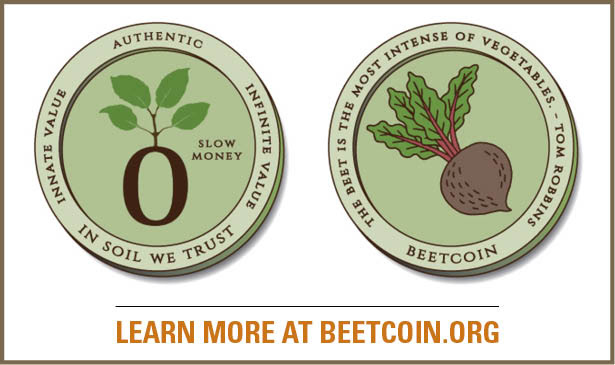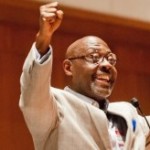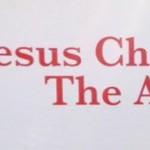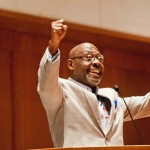Author’s Note: I recently had the opportunity to speak at Seattle University’s annual Search for Meaning Book Festival. The presentation, a general overview of Slow Church, went very well. A couple folks asked for copies of my presentation script. I only had one hard copy to give, which is one reason why I’m posting it here. It’s significantly longer than our usual posts, so I’ve also created a downloadable PDF. If I did things correctly, you should also be download a PDF version here.
SLOW CHURCH:
BECAUSE YOU CAN’T FRANCHISE THE KINGDOM OF GOD
Seattle University
Search for Meaning Book Festival
March 9, 2013 – 9:00 a.m.
I.
I’d like to thank Seattle University’s School of Theology & Ministry for extending the invitation to be here this morning. The roster for this conference is so jam-packed with great writers – Sherman Alexie, Michael Chabon, Paul Elie, Tony Kriz, among so many other personal favorites – that I feel like I’ve snuck through the back door of some great literary cocktail party.
I grew up idolizing The New Yorker magazine. In my imagination, the rewards of the writing life were characterized less by bestsellers and fat advances, and more by years-long conversations over lunch with Harold Ross and Dorothy Parker.
We’re hundreds of miles away from and about 90 years too late for the Algonquin Roundtable – and it might be a stretch to describe myself as a “successful” writer – but, like you, I’m looking forward to a full day of great discussions about where the search for human meaning has taken us.
II.
Slow Church is inspired by the language and philosophy of the Slow Food movement to rethink the ways in which we live life together in our faith communities. Just as Slow Food offers a pointed critique of industrialized food culture and agriculture, the language of Slow Church can help us unmask and repent of our industrialized and homogenized approaches to Christian community. My hope is that it can also help fire our imaginations with a rich vision of the holistic, interconnected, and abundant life together to which we’ve been called through Christ Jesus.
I’d like to start by telling “a tale of two manifestoes.”
In February 1909, a 32 year-old Italian poet, playwright, and critic named Filippo Tommaso Marinetti caused an international stir when he published, in the French newspaper Le Figaro, “The Foundation and Manifesto of Futurism.”
The Futurist Manifesto, which launched the Futurist literary and political movement, exalted the future over the past, violence and aggression over peace and patience, immorality over morality, men over women, the young over the old, the machine over the land, and the known over the unknown.
Marinetti wrote: “We will sing of great crowds excited by work, by pleasure, and by riot; we will sing of the multicolored, polyphonic tides of revolution in the modern capitals…”
He called for museums and libraries to be demolished. He declared war to be the hygiene of the world.
And Marinetti declared that the world’s splendor had been “enriched” by a new beauty: speed. “Time and Space died yesterday,” he wrote. “We already live in the absolute, because we have created eternal, omnipresent speed.”
The Futurist Manifesto was grotesque and fascistic, but in many ways it got what it called for. The 20th century turned out to be the bloodiest, most cacophonous in human history. It was a century in which our willingness to destroy each other and plunder the planet were outstripped only by the technological advances to do them more completely. Above all, perhaps, there was speed, which irrevocably reshaped society with fast cars, fast food, fast computers, and the fast track.
Eighty years after the publication of the Futurist Manifesto, another international movement with Italian roots was launched in Paris. The Slow Food Manifesto was signed in 1989 by delegates from 15 countries.
The Slow Food Manifesto starts off this way: “Our century, which began and has developed under the insignia of industrial civilization, first invented the machine and then took it as its life model.”
The International Slow Food Movement was formed as an act of resistance against Fast Life, the homogenizing effects of globalization – what Alice Waters, the executive chef of Chez Pannise restaurant calls “global standardization” – and the attendant loss of natural and cultural diversity.
The name “Slow Food” was inspired by a rally against the opening of a McDonald’s near the Spanish Steps in Rome. Carlo Petrini, the journalist who co-founded Slow Food, helped organize the demonstration, during which the crowd chanted, “We don’t want fast food! We want slow food!” The weapons of protest that day were bowls of penne pasta.
Today, Slow Food is comprised of 1,300 local chapters and 100,000 members in 53 countries. Each chapter is dedicated to protecting local food and wine producers, preserving food traditions, and promoting the pleasures of conviviality. In fact, local Slow Food chapters are called convivia.
Slow Food has inspired other Slow campaigns.
Slow City was launched by a group of Italian mayors in October 1999 and now includes more than 140 communities in 23 countries. Eligible Slow Cities must have populations under 50,000 and are evaluated in the categories of sustainable agriculture, local food cultivation, land use, and hospitality, among others.
Slow City Chairman Pier Giorgio Oliveti has said that these cities are betting “on values that thwart alienation.” They want “to limit the spread of ‘non-places’…”
Other manifestations include Slow Money, Slow Gardening, Slow Parenting, Slow Reading, and Slow Art.
There is even a World Slow Day, which some playful Italians recently celebrated by offering free public transportation, poetry contests, and free yoga and tai chi lessons. They issued fake citations to pedestrians who were walking too fast or taking too direct a route.
While these efforts differ in scope, scale, and strategy, they have many things in common, most obviously their opposition to what the Canadian journalist Carl Honoré describes as “the cult of speed.”
Fast and slow, Honoré writes, are not just rates of change. “They are shorthand for ways of being, or philosophies of life. Fast is busy, controlling, aggressive, hurried, analytical, stressed, superficial, impatient, active, quantity-over-quality. Slow is the opposite: calm, careful, receptive, still, intuitive, unhurried, patient, reflective, quality-over-quantity. It is about making real and meaningful connections – with people, culture, work, food, everything.”
III.
For better and for worse, the North American church seems to be just as susceptible as the rest of culture to the allure of fast life, or what the sociologist George Ritzer has termed “McDonaldization” – that is, “the process by which the principles of the fast-food restaurant are coming to dominate more and more sectors of American society as well as the rest of the world.”
Ritzer described four dimensions of McDonaldization: efficiency, predictability, calculability, and control – or at least the illusion of control. These trends originate at least as far back as the Industrial Revolution.
Western Christianity’s symbiotic relationship with modernity, industrialization, and McDonaldization has often led it to devise shortcuts that try to circumvent some of the messy or inefficient facets of faith and Christian practice. Instead of cultivating a deep, holistic discipleship that touches every aspect of our lives, we’ve tended to compartmentalize our faith to Sunday mornings where it can be more easily managed. Following Jesus has been diminished to a privatized faith, rather than a lifelong apprenticeship practiced in the context of Christian community.
Many churches, particularly those driven by Church Growth models, come dangerously close to reducing Christianity to a commodity that can be packaged, marketed, and sold. For those who might not be familiar, the Church Growth movement has its roots in the 1950s and 1960s when missiologists began applying insights from the social and behavioral sciences to help devise ways of presenting the gospel in ways that appeal to highly targeted audiences.
Church Growth models tend to emphasize methodologies, formulas, and quantifiable results; they have a “come and hear” mentality that limits church life to the four walls of a sanctuary rather than a mission that moves “into the ordinary, everyday life of the neighborhoods and communities where we live” (Roxburgh).
Often associated with mega-churches and “seeker-sensitive” churches, the Church Growth movement has been hugely influential, moving the goalposts even for many small churches that may not identify with the movement outright. Michael Frost and Alan Hirsch estimate that perhaps 95% of Western churches operate with a “come and hear” mentality. These “attractional churches all but require that non-Christians enter our sanctified spaces to hear the gospel. Frost and Hirsch make a convincing case that the attractional church will be of limited effectiveness in post-Christendom, calling instead for an “incarnational” church that “disseminates itself and seeps into the cracks and crevices of a society” in order to represent Christ to the world.
The farmer Joel Salatin has written that conventional agriculture experts view the soil as merely a convenient way to hold up the plant while it is fed from the top in the form of ever-increasing doses of chemical fertilizers. He describes this process as superimposing a mechanistic mindset onto a biological world. Nature, in contrast, feeds the plants from the bottom up, through the soil. Thus for the conscientious farmer, the health of the soil is a top priority.
I think the American church is often enticed by shortcuts that are the church equivalent of imposing a mechanistic mindset onto a biological world. When evaluated in terms of efficiency – defined as the easiest way to get someone from here to there, from unsaved to saved, from unchurched to churched – these top-down inputs seem to yield impressive short-term results: they can sometimes pack the pews. So on the upside the church has been busy. On the downside, it’s not clear at what long-term costs these methods have been employed, or how helpful and sustainable they will be going forward.
Plug-and-play ministries, target marketing, celebrity pastors, tightly scripted worship performances, corporate branding, and the substitution of nonhuman technology for human work, programs upon programs, church growth formulas that can be applied without deference to local context – these entice us with promises of miraculous results in just a few easy steps.
But as evidenced by the growth of the Slow movements – Slow Food, Slow City, Slow Money, and others – Americans seem increasingly wary of being sold another product so scrubbed and polished and unsurprising that you would never guess it had been born of soil and sun and shit.
IV.
We believe Slow Food and the other Slow movements hold important lessons for the American church. They compel us to ask ourselves tough questions about the ground our faith communities have ceded to the cult of speed. And they invite all of us – clergy, theologians, and laypeople – to start exploring and experimenting with the possibilities of Slow Church. Not as another Church Growth strategy. But as a way of re-visioning what it means to be communities of Jesus followers gathered and rooted in particular places at a particular time.
The Slow Food movement is fundamentally about the richness of a shared life with the neighbors who grow our food, prepare our food, and share our food. Slow Church is a call for intentionality. An awareness of our mutual interdependence with all people and all creation. An attentiveness to the world around us and to the work God is doing in our neighborhoods.
A McDonald’s or Burger King restaurant is essentially a caloric filling station. In the same way, a church that has entrusted itself too much to the forces of McDonaldization can become a spiritual filling station, a Sunday morning pit stop before we head back out into the rat race. Churches become dispensaries of religious good and services, which falsely bifurcates life into the spiritual and nonspiritual.
Slow Church seeks to move away from the compartmentalized paradigm. The good news of the Kingdom of God is pertinent to all aspects of life. The world is fallen. And the way God has chosen to redeem the world is place by place, by gathering communities that together seek the common good – the redemption, the shalom of particular places. In the book of Jeremiah, God tells God’s people who had been exiled to Babylon:
“Build houses and settle down; plant gardens and eat what they produce. Marry and have sons and daughters; find wives for your sons and give your daughters in marriage, so that they too may have sons and daughters. Increase in number there; do not decrease. Also, seek the peace [the shalom] and prosperity of the city to which I have carried you into exile. Pray to the Lord for it, because if it prospers, you too will prosper.” (29:5-7)
Is it time for a Slow Church Manifesto? Maybe not. Our goal for the book, which is scheduled to be published by InterVarsity Press in late 2013 – our goal for the Slow Church blog, and my goal for this talk – is to help inaugurate a broad and long and even slow conversation on the topic.
By necessity, that conversation will include issues of justice, manageable scale, place, diversity, seasonality, an economy of redistribution, pleasure, beauty, time, and shared traditions.
Though we obviously don’t have time to rigorously unpack all these topics, I’d like to take a closer look at just a few: Time and Place.
(Now is the perfect place to mention that many of the following ideas aren’t mine alone. The implications of Slow Church have been worked out in conjunction with my “Slow Church” co-author, Chris Smith, who is also the editor of the Englewood Review of Books. And they have been witnessed firsthand in faith communities around the country – faith communities of all stripes, including house churches, new monastic communities, big churches, small churches, Catholic and Protestant, Mennonite and Quaker, mainline and evangelical. Occasionally these communities use the language of Slow Church, but usually not. Rather than trying to coalesce churches around new models and or a new movement, one of the biggest contributions of Slow Church may be just to provide a useful vernacular to describe a wide range of exciting things that are already happening around the country.)
V.
Time: One-size-fits-all success models don’t take the time to discover the assets, needs, history, diversity, traditions, and values of a community. Mike Bowling, pastor of Englewood Christian Church, where my “Slow Church” co-author is a member, once described this process to me as “exegeting the place.” The models don’t take the time because they don’t have the time. When you believe you are racing the end of history, it is easy for efficiency to become an idol, and church can become just another Jesus-delivery-system.
I lived in Nebraska when I was younger. My home church was a big church on the outskirts of town. When I started attending the church’s big college group I soon discovered that the college group patterned itself in many ways on Willow Creek, the mega-church in the Chicago suburbs that has an average weekend attendance of 24,000. Willow Creek Church was a pioneer of the seeker-sensitive, purpose-driven, program-driven approach to Church Growth. As author James Twitchell (author of “Shopping for God”) and others have noted, Willow Creek’s vision of church life was heavily influenced by the principles of business management. In fact, outside Pastor Bill Hybels’ office hung a poster that said, “What is our business? Who is our customer? What does the customer consider value?”
In 2007, Willow Creek Church did a brave thing. It published the results of a massive four-year study that found that many of the hallmarks of their Church Growth strategy—some of which had cost millions of dollars–weren’t working. They were beefing up attendance but they weren’t necessarily yielding spiritual growth and deeper discipleship.
But back in the late 1990s when I was attending this church in Lincoln, my college group leaders were traveling to Willow Creek for conferences, coming back with materials, trying to replicate Willow Creek’s programs in Lincoln, and expecting the same result. There was something that didn’t sit right with me about all this.
One night I was invited to attend a banquet for a nationally syndicated Christian talk show. One of the other guests that night was a well-known author and Bible teacher who went to our church. His name was Warren Wiersbe. During the banquet he came over to the table where a friend and I were sitting. He asked us how things were going, and somehow we got on the topic of the church college group. I expressed some of my frustrations about how we seemed to be copying Willow Creek. Dr. Wiersbe said something to me that night that stuck with me…and planted an early seed of Slow Church. He said:
“Just remember, you can never franchise the blessings of God.”
The subtitle for this talk is that “you can’t franchise the Kingdom of God.” As a friend and mentor recently reminded me, the Kingdom of God does have certain “repeatable characteristics.” The gospel is supposed to be good news for the poor, for example.
But the Kingdom of God isn’t something that can be bought and sold, as we see in the story of Simon the Magician in Acts 8. And we see in Jesus’ description of the new wine and old wineskins in Mark 2 that it is the nature of the gospel to bust old paradigms.
And when Jesus compares the Kingdom of God to yeast in dough and to a mustard seed, we are reminded that God’s transformation often starts small, comes slowly, working outward from the place where the change began. In an age in which instant gratification reigns supreme, these parables can be difficult for us to hear. These frameworks for growth are organic. They can’t be precisely replicated and they are ultimately mysterious.
Slow Church operates from a perspective of Time that is peculiar to our culture and peculiar even to the American church. We are purposeful but unhurried. Serving, as we do, a God who acts in Time but is yet unbound by it, we can afford to enter a neighborhood with the posture of the listener. We can start work we won’t see the end of. “Plant sequoias,” urges Wendell Berry:
Put your faith in the two inches of humus
that will build under the trees
every thousand years.
One of the dangers of Church Growth models is that it can lead us to “peoples” rather than “people.” We can get so focused on programs that we don’t have time to be generous, to practice Sabbath days of rest and delight, to practice hospitality, to fast, to pray, to party, to talk with each other. It took Jesus three years to plant the seeds of what would ultimately become a worldwide church. And he always had time for the hurting person right in front of him.
A Slow Church philosophy enables us to settle into the good, long labor of spiritual formation. I recently interviewed Kyle Childress, who has been the pastor of Austin Heights Baptist Church in Nacogdoches, Texas for 21 years. Childress told me he knows there are some people who come into his church at eleven o’clock on Sunday morning looking for a deep spiritual experience, but that they want it instantaneously. They want a light show, exotic music, and a dynamic speaker.
But, Childress says, “there is so much about being a Christian that isn’t like that. Slow Church is about taking the time with God, with one another, and with yourself – and not only take the time, but taking time over time. That makes a big difference.”
Later in the conversation, Childress told me, “The danger of Fast Church is what the poet Christian Wiman calls the ‘frantic instant’ of our culture. My concern is the difficulty in raising Christians who have both depth and strength to be sustained through good times and hard times – to be faithful and to be the church whatever circumstances they are in. And I think that takes time.”
VI.
Place: Another key to understanding Slow Church is captured in the 17th century phrase le gout de terroir, which can be translated “the taste of the place.”
Carlo Petrini, the cofounder of Slow Food, writes often about terroir as “the combination of natural factors (soil, water, slope, height above sea level, vegetation, microclimate) and human ones (tradition and practice and cultivation) that gives a unique character to each small agricultural locality and the food grown, raised, made, and cooked there.”
Thus, a pinot noir from Oregon’s Willamette Valley, where I live, might take on the taste and texture of the grape, the soil, the barrel, and the late frost.
In the same way, Slow Church is rooted in the natural, human, and spiritual cultures of a particular place. It is a distinctively local expression of the global body of Christ. John 1:14 says, “And the Word became flesh and dwelt among us…” On our wall at home we have “The Message” version of that verse: “The Word became flesh and blood, and moved into the neighborhood.”
In his book, Missional: Joining God in the Neighborhood, Alan Roxburgh writes that the way to know God is to “[enter] into the ordinary, everyday life of the neighborhoods where we live.”
He says later: “I’m appealing for the recovery of local and particular ways of calling forth the personal once more in the towns and neighborhoods where we live. For me, this is about dwelling among, working beside, and eating at the table of the men and women who live in our communities, who long for the personal rather than the pitch.”
My friend, Paul Sparks, whose organization The Parish Collective is on the forefront of the re-localization of the church, what they call “the new parish movement,” talks about praying the “reverse prayer of Jabez”:
God,
Shrink our territory,
And narrow our boundaries
That we might truly be a blessing to all.
Slow Church happens when people live, work, worship, eat, grow, learn, heal, and play in proximity to each other, often outside the walls of the sanctuary.
The Mission of God in the world is centered upon redeeming and reconciling of creation. How does God intend to accomplish this reconciliation? One of the great flaws of modernity was its preference for the generic, for interchangeable parts. But the more we consider the wonderful diversity of God’s creation, the more skeptical we must become about the possibility of universal solutions. God is reconciling all creation, but this reconciliation unfolds in a manner that is attentive to, not dismissive of, diversity.
Jesus, for example, was born in a manger in Bethlehem, among a particular people at a particular time in history. After Jesus’s death and resurrection, his disciples dispersed throughout the world and planted church communities that were manifestations of Christ’s body in their particular places. These early church communities shared life together in such a way that they were maturing together into “the fullness of Christ” (Ephesians 4:13).
The church has historically spoken of Christ’s coming to earth as his incarnation—his enfleshment. Christ’s incarnation isn’t limited to the first century. It continues into the present through the church—the body of Christ—through communities of believers who are faithfully rooted in their places, embodying Christ in ways that can be experienced and known by the particular sort of people who live in those places.
Slow Church believes this continuous incarnation of Christ’s body is at the heart of God’s plan for reconciliation. But in order for the joyous and freeing reign of God to leaven creation in this way, there must be a rich commitment to rootedness, a virtue the Benedictines have long called stability.
Many faith communities have put down only shallow roots in their neighborhood, or no roots at all. Ask yourself this question: “If tomorrow our church was magically lifted off the ground and moved to a location fifteen miles away, would anyone notice we were gone?” The answer to that question should be a cold, hard look in the mirror for many of us.
Many of our churches are moving, though not by magic. In Indianapolis, Lincoln, Los Angeles, Shreveport, Falls Church, and Salem, in towns and cities across the country, churches are migrating away from the city center. They are lured to greener suburban pastures by the prospects of cheaper land, ambitious building projects, and abundant parking.
When contemplating “church flight,” we should ask ourselves another question: “What kind of witness do we bear to the neighbors we leave behind?” One of the great legacies of the Roman Catholic tradition is the notion of the parish: churches that are rooted in particular places, and among the people that live there. Unless churches today can recover a sense of parish responsibility, belonging to people and place, we will continue to propagate the kind of disembodied, modernist Christianity that can lead to racial, social, and ecological injustices.
The rural community my family and I call home was voted one of the “Top 10 Coolest Small Towns in America” a few years back. And, unlike many rural communities, ours is growing in population thanks in part to an influx of young people.
But neighborhoods have life cycles. My little town may not always be considered cool, and trendy is not the same thing as flourishing. If my family and I are going to make a commitment to our place it needs to be for better or for worse, through thick and thin.
One of my heroes, the writer Wallace Stegner, liked to distinguish between two archetypes of the American West: the “boomer” and the “sticker.” From gold strikes to flipping houses, boomers live in perpetual motion, always looking for Easy Street or the next big killing. Meanwhile, stickers quietly go about the business of staying put, rooting themselves in a place and a community for the long haul. The mythology of the American West – not to mention our NFL mascots – tends to glorify the boomers (cowboys, ’49ers, etc.) and overlook the stickers. I’ve come to recognize even in my own life the boomer’s desire to pull up stakes and light out for new territory, a biannual urge so predictable and powerful that fighting it is like working against muscle memory.
But, thanks in part to folks like the Parish Collective, who I’ve already mentioned, my co-author Chris, writers like Wallace Stegner and Wendell Berry, and friends that I’ve met through the Slow Church project, I spend a little less time gazing at the horizon and a little more time paying attention to where I am now. Ghost towns, cattle trails, and abandoned mines have become less interesting to me than living communities held together by the affection and bonds of mutual support that can only develop in proximity and over time.
VII.
We are bound one to another, but a culture build on speed wants to fling us out from the center like a centrifuge. Thus, to commit ourselves to nearness and stability, and to trust God that he have time to take the time, is to take a stand against alienation.
Very early in the writing process, when the Slow Church project was little more than a gleam in its authors’ eyes, it was twice suggested to us (very politely, I hasten to add) that a book about “slow church” should be written by a specialist.
It’s true that neither my co-author nor I are vocational pastors, expert theologians, or professional church planters. In fact, we are proud amateurs—but in the older, more interesting sense of that word. The word “amateur” is most commonly used today to mean (a) someone who engages in a pursuit on an unpaid basis, (b) someone who is “contemptibly inept” at an activity, or (c) both. But “amateur” comes to us from the French (and before that from the Latin) and it literally means “lover.” It implies a passionate love for the thing itself, quite separate from any compensation (money, fame, career) that could come from it.
Slow Food wasn’t started by farmers and chefs; it was started by eaters who stood up and declared that they weren’t going to be content being passive consumers of industrialized food. We think it’s similarly appropriate that a lot of the energy in the early stages of the Slow Church conversation comes from non-specialists who are motivated by a love of God, a love for the Body of Christ in the world, and a desire to be more than passive consumers of religious goods and services, one day a week. We want more risk, beauty, and wonder than can be experienced at a spiritual filling station. We want some skin in the game.
“Eating is an agricultural act,” Wendell Berry famously said, and Slow Food views consumers as active participants in the production process. An eater who knows where her food comes from, knows how it got to her table, and supports local farmers becomes nothing less than a co-producer. Similarly, Slow Church is more than a consumerist experience. It goes beyond just offering people a safe haven on Sunday morning from storms of Fast Life. Slow Church is a way of being authentically connected as co-producers to a Story that is as big as the planet (bigger) and as intimate as our own backyard.
Thank you.












